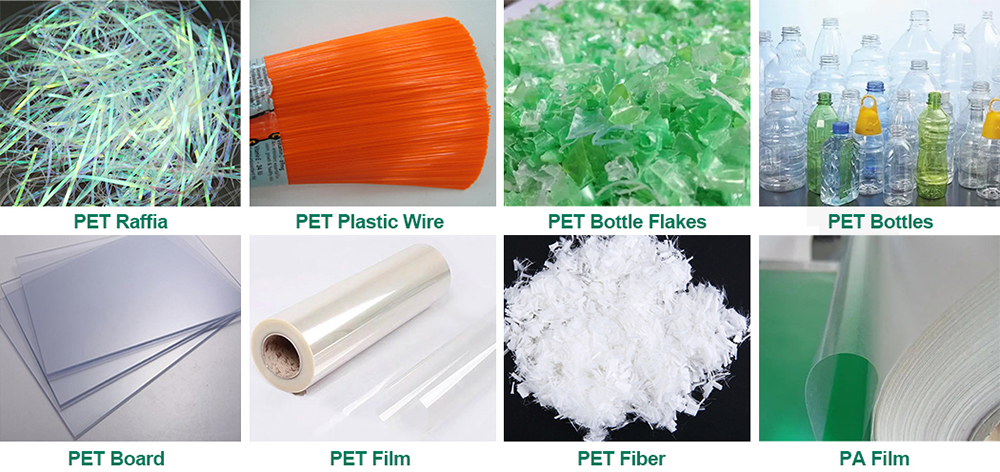Article paragraph
Ⅰ Characteristics of PET plastic bottles
Ⅱ PET plastic bottle recycling method
Ⅲ The use of PET plastic bottles after recycling
PET plastic bottle characteristics
Polyethylene terephthalate is the most important variety of thermoplastic polyester, English name Polythylene terephthalate referred to as PET or PETP (hereinafter referred to as PET), commonly known as polyester resin. It is a polycondensate of terephthalic acid and ethylene glycol, and together with PBT, it is collectively referred to as thermoplastic polyester, or saturated polyester. PET is a milky white or light yellow highly crystalline polymer with a smooth and shiny surface.
It has good creep resistance, fatigue resistance, friction resistance and dimensional stability, low wear and high hardness, and has the greatest toughness among thermoplastics; good electrical insulation performance, little effect of temperature, but poor corona resistance. Non-toxic, weather resistant, good chemical stability, low water absorption, weak acid and organic solvent resistance
Pet plastic bottles are the most widely used beverage packaging. In addition to the daily packaging of carbonated beverages, fruit juices, tea beverages, etc., they are also widely used in many fields such as food, medicine, and chemical industry. PET plastic has a wide range of applications in the packaging field, whether it is packaging film, roll material, or beer bottles, PET plastic is used. But when these materials are discarded, there is the question of what to do with them. The recycling of PET plastic bottles can not only solve environmental protection problems, but also can be used as a new raw material resource to alleviate the contradiction of the global shortage of PET raw materials.
PET plastic bottle recycling method
1. Physical recycling method 1 - shredding waste PET plastic bottles into pieces
The physical recycling method of PETt plastic bottles is relatively simple, mainly drying and granulating the cleaned and discarded pet plastic bottles. Cut waste PET plastic bottles into pieces, separate HDPE, aluminum, paper and adhesive from PET, and then wash, dry and pelletize the PET fragments.
2. Physical recovery method 2 - first separation and then processing
First, the impurities such as caps, caps and labels that are not PET on the discarded PET plastic bottles are separated by mechanical methods, and then washed and dried, usually using a centrifugal dehydrator to reduce the moisture content of the fragments to 2%. Dry in a tubular dryer to reduce the moisture content to 0.5% and granulate.
3. Chemical recycling methods
A method of depolymerizing waste PET plastic bottles under certain reaction conditions to generate useful chemicals, such as the production of low-grade fuel gasoline.
The uses of PET pellets after physical or chemical recycling are as follows:
1. To re-manufacture PET plastic bottles, recycled pellets cannot be used in direct contact with food, but can be used in the middle layer of three-layer PET plastic bottles, and then made into carbonated beverage bottles.
2. Spinning to make fibers, recycled PET materials can be used to make fibers, which can be used as sleeping bags, mattresses, pillow cores, felts, etc.
3. Glass fiber reinforced material, glass fiber reinforced recycled PET has good heat resistance and mechanical strength, and can be used to make auto parts, such as heat-resistant automobile wheel covers.
4. Blending modification, recycled PET material can be blended with other polymers to produce various modified materials, such as blending with PE, PET blends with improved impact performance can be obtained; if a little polypropylene is added, The dimensional stability of the blends can be significantly improved. Since the polarities of PE and PET are quite different, compatibility treatment is required during blending. Generally, the compatibility is improved by graft modification of polyolefin.
5. Discarded PET plastic bottles are processed and reprocessed. In addition to being able to make PET plastic bottles, they can also be used to make sleeping bags, pillow cores, car wheel covers, etc. The global consumption of PET plastic bottles is very high. PET plastic bottles can be reprocessed and turned waste into treasure, which not only solves the problem of insufficient PET raw materials, but also reduces environmental pollution and resource waste, which is of great benefit to sustainable development. Its recycling technology has very broad prospects.
What are the recycling methods and uses of PET plastic bottles after recycling
2021/03/03